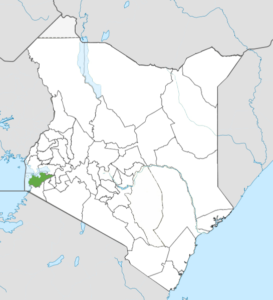A Woman’s Place is in a Body Bag
 A photo of the Migori County Assembly building. Source: https://bit.ly/2QOekdG
A photo of the Migori County Assembly building. Source: https://bit.ly/2QOekdG
CW: Sexual Violence, Abuse
On September 3rd, a second-year Rongo University student, Sharon Otieno, was declared missing after meeting with The Nation journalist Barrack Oduor. The two met at Graca Hotel where Oduor was gathering information regarding the young woman’s claim that a politician, Migori County governor Okoth Obado, fathered her child but was refusing responsibility for the pregnancy.
The events that followed remain unclear, but what is known thus far is that the two were mysteriously lured by Governor Obado’s aide, Michael Oyamo, out of the hotel. Oduor and Otieno were then forced into a black Toyota Fielder allegedly driven by one of Obado’s senior officials, Jack Gombe. Journalist Barrack Oduor narrowly escaped by jumping out of the moving vehicle. Sharon, on the other hand, was unable to elude the kidnappers. Her body was found within days of the attack in Kodera forest in Homa Bay, a part of Western Kenya.
The autopsy concluded on Friday, September 7th with doctor Johanson Oduor finding that the attacker stabbed Sharon in the neck, back, and abdomen a total of eight times, not only killing her but also perforating her placenta and killing the baby. She was also badly bruised, which Dr. Oduor claimed was likely evidence of a struggle prior to her death. Additionally, there were several used condoms at the scene of the crime, indicating the attackers also raped her.
The director of criminal investigations collected DNA samples from key murder suspects: the journalist Barrack Oduor, Governor Okoth Obado, and Obado’s assistant, Michael Oyamo. Additionally, Oyamo and “former Member of County Assembly (MCA) Lawrence Mula — have been arrested and arraigned in court over Sharon’s murder.”
The Migori governor was arrested a few weeks later on September 21st following the DNA report’s findings that confirmed he was indeed the father of Ms. Otieno’s child. He remains in custody and will have a hearing on October 24th to determine the conditions of his bail.
The grisly murder of Sharon Otieno shocked not only Kenya, but the world. While news agencies keep a close eye on how the Directorate of Criminal Investigations (DCI) handles Sharon’s case, crimes like these happen and continue to occur with unrelenting regularity.
Kidnapping in Kenya
The National Crime Research Center published findings regarding the frequency of kidnapping in Kenya, the potential reasons for it, the most vulnerable or common times that individuals are kidnapped, and difficulties regarding prevention and mitigation, as it is harder to find and predict kidnappers who are family members.
The report went further to include an academic interpretation of not only the incidence of kidnapping, but the motives of kidnappers, which groups of people are most vulnerable, and other factors associated with decision making. The authors received information from several stakeholders including police informants, kidnapping victims, and perpetrators.
Although Sharon Otieno was abducted in Homa Bay County along the Western border, the report found that central Kenya—surrounding the capital, Nairobi—faced the greatest kidnapping challenge despite its overall incidence falling in all counties over the past decade. Regardless of this decrease, it is notable that three-quarters of interviewees still consider kidnapping a national security issue. Locally, opinions were less coherent. Around sixty percent of respondents asserted that kidnapping was a local security issue in spite of the incidence of kidnapping in the area. The authors stated that the disparity between national and local concern may be due to the amount of information available to community members.
A key component of the report documents aggregate findings regarding perpetrator and victim profiles, finding that women are most at risk for kidnapping while men and romantic partners are those who most commonly kidnap. Sharon, a young woman allegedly seeking to expose a powerful political figure with whom she had an intimate relationship, was particularly at risk. From this, it is clear that kidnapping is not a new or unknown phenomenon in Kenya, so why has Sharon’s case garnered so much attention?

Women in Society
A key area of the media focus has been on the political nature of the murder. All eyes are on Governor Obado and his affiliates while the investigation is underway. Journalists share report after report detailing the arrests and their affiliation to the governor. His own press secretary told reporters in September that any speculation of the governor’s involvement was a ploy used by the opposition to discredit him. Sharon’s death also intensified senate races in Migori county. The arrest and subsequent detention of his supporter, governor Obado, apparently dealt a blow to Migori senator Eddy Oketh’s election campaign. Moreover, opposition from former presidential candidate, Raila Odinga of the Orange Democratic Party, seized upon the murder investigation as an opportunity to present a narrative that Obado’s government was in a moral crisis.
Public responses did not go far enough to adequately acknowledge the widespread nature of violence against women—rape, kidnapping, and murder. Homa Bay representatives demanded that perpetrators be brought to justice while also claiming that Sharon’s fate should be a “lesson to all girls” not to accept ‘sponsors’, financially stable older men who begin relationships with young women. Furthermore, they claimed that it is for “mothers to guard their daughters and take it upon themselves to know what is happening in their lives.” Statements like these reveal that women—daughters, mothers—are expected to be responsible for their own safety while men’s predatory behaviors are neglected. It is quite apparent that the safety of women, across generations, continues to be dismissed by society and government in favour of policy that enables men’s predatory behaviour. This may be due in part to the tendency to victim-blame, a phenomenon not unique to Kenya.
Furthermore, as in all societies, there is little discussion from mainstream politicians and media outlets in Kenya regarding the power imbalance between ‘sponsors’ like Governor Okoth Obado and women like Sharon Otieno. Blame attributed to the woman for what many consider foolishly or naively trusting a man with money, power, or connections. The focus remains on how the woman behaved instead of the larger picture behind power imbalances in these relationships — the common and broader societal acceptance of financial manipulation by men. There is little discussion of changing norms and poverty that makes relationships like these attractive. Nor regarding the oppressive patriarchal society in which men feel entitled to power, control, and dominance over women. The killers who raped Sharon—a signal of power—prior to killing her serve as an example of this very concept. Certainly, the perpetrators sexually assaulted Sharon to inflict maximum physical agony. However, they also did so to strip her of liberty by intruding her very being against her will. Indeed, such a violation revealed her absolute powerlessness in a physical sense, but also served to exact shame. Furthermore, the focus on women’s behavior overlooks all factors – from individual acts to systemic inequalities – that create an environment where atrocities like this are committed by men against women and other marginalized groups.

The media went further to describe her as anti-social and a mystery to even friends and family. To find out more, news organizations interviewed her husband from whom she was separated at the time of the murder. He declined to discuss the matter, fueling journalists’ speculations about their relationship despite their separation before she died. This characterization is significant for several reasons. Female stereotypes include outgoing personalities and strong communication skills which starkly contrast Otieno’s characterization as cold and mysterious. Furthermore, people, women in particular, who are considered anti-social or as if they reject society’s general mores kindle less sympathy; making it seem more legitimate to ignore the issue or blame the victim.
In Sharon Otieno’s case, many jumped at her social media posts depicting a lavish lifestyle. According to media accounts, she often posted about her “opulent” getaways while her mother cared for her three children. Beyond simple investigation, such discussion lends little information regarding her relation to furthering the investigation or promoting actionable discourse to prevent further kidnappings. Instead, this account stems from a universal misunderstanding that violence against women is legitimate, when it comes to women who fail to adhere to societal expectations.
Additionally, Ms. Otieno was perceived to have failed her role as a mother. This is a perceived neglect of her womanly responsibilities, or more succinctly, a perceived noncompliance with the social stereotypes of which “mothers are expected to have nearly super-human capacities to nurture and guide. Signs of imperfection in her children or even signs that she may have goals beyond motherhood (e.g., career, a better marriage) can cause her to fall rapidly from the pedestal [society accords her in this role]”.
Some social media commentators may think they are the arbiters of justice, claiming that Otieno’s fate was inevitable or that she incorrectly managed her relationship with a sponsor; precipitating her murder. What investigators, friends, journalists, politicians, and onlookers have failed to find, however, was a legitimate justification for the abduction, abuse, rape, and murder of a twenty-six-year-old woman. According to the Kenyan Penal Code, “[a]ny person who of malice aforethought causes death of another person by an unlawful act or omission is guilty of murder.” Thus, despite online commentary, womanhood or sponsorship or youth or pregnancy are not protected as defendable reasons to kill.
Since the investigation began in early September, several women and girls have been reported murdered, abducted, molested, and found with their throats slit. These victims all have one thing in common: they are female. In the short-term, rigorous investigation is required to find the perpetrators of these crimes and bring them to justice. In the long-term, major cultural shifts must take place worldwide to erase patriarchal domination and enhance women’s equality.
The featured image is licensed under the Creative Commons Attribution-Share Alike 4.0 International license.
Edited by Gracie Webb
